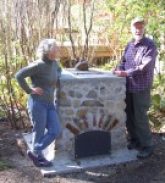
You live where you want to live, in an area with plenty of wildlife, large and small. In fact, being close to nature is one reason you chose to live there.
You want to compost, because you know that composting is the only ecologically sound solution to disposing of kitchen waste.
But setting out a snack bar for bears is just plain dangerous!
Most composters can’t begin to keep out bears. Few are even safe against a determined raccoon.
No one wants to meet a mother bear while out emptying the compost bucket. And while they may look cute, a raccoon can kill your cat or dog, and seriously injure a small child.
Skunks? Enough said.
Even rats can cause thousands of dollars worth of damage if they’re drawn by your compost and end up moving into your house to stay close to the food.

Laurie Chambers invented the Critter-Proof Composter™ after watching a bear claw her way into his new cedar plank compost bin in 20 minutes flat.
He built his first Critter-Proof Composter™ in 2008. Friends wanted them. The local elementary School wanted one. So did the community garden.
There are now close to 20 Critter-Proof Composters™ up and running, including one in the City of Vancouver’s Urban Farmer Compost Demonstration Garden. Not only do we know it keeps out the bears, we know it produces magnificent compost.
But Laurie is just one guy, and he can’t solve the world’s composting problems alone.
That’s why we’ve collaborated to create HOW TO BUILD A CRITTER-PROOF COMPOSTER™, a detailed, richly illustrated how-to instruction manual that will teach you to build your own.
It’s taken two years to produce, and several months more to test. Now we’re finally ready to share it with the world.
Both Laurie and I care about the environment, and we care about wildlife. We’d like to make some money from the sale of the manual, because we put a lot of time and energy into creating it. But for us, it’s less about money than about spreading a really great idea as far and as wide as we can.
This is your chance to come in early. And to reward those of you who want to help us send Critter-Proof Composters™ into every corner of the world, we’re making a special, deeply discounted introductory offer.
Buy the manual as a downloadable ebook. Print it yourself and save the mailing costs. $69US/$39US
We’ve provided you with everything you need to succeed. We hired an architect to do the drawings of the forms. If you can read drawings, you’ll find clear and easy to understand. We’ve photographed every step along the way.
Clear photos and step-by-step instructions
Before you decide to buy, you have to know that building a Critter-Proof Composter™ is not for everyone.
If you’re a contractor, a mason, a landscaper or even just all-round handy, then fine, go ahead.
But if you’ve never poured concrete, or built anything from plywood, you might want to think twice. If you decide to go ahead, know that building the forms is one of the most technically challenging parts.
Once you have the forms, the rest of the project requires less in the way of skill – although there is artistry involved in the laying the stones so the face of the composter looks good.
The cost of building the composter will vary depending on where you live, and whether or not you have a supply of suitable rocks, or have to buy them. Your costs will include three sheets of plywood, some cement and gravel, the aluminum doors, the hardware, and a small amount of additional wood. And when you’re done, the forms can be used again
Buy the manual as a downloadable ebook. Print it yourself and save the mailing costs. $69US/$39US
If for any reason you are dissatisfied with the manual, we’ll refund your money, no questions asked, on receipt of the book, or if you downloaded it, with your word that you’ll delete the file.
p.s. Buy now and you’ll save.
p.p.s. Not ready to buy now? Send us your email – the sign-up box is in the upper right hand corner – and we’ll keep you posted on Critter-Proof news, including the new double capacity composter Laurie is developing.
If you care about the environment and want to compost, the real problems come on four legs, in small, medium and large sizes: rats, raccoons and black bears.
The Critter-Proof Composter is made using concrete formwork, faced with stone, with recessed bolts holding aluminum lid, front door and back vent in place. As unique as it looks, this design uses proven methods for producing compost

I thought the manual was great.
It has been wonderful building something that works with the Earth, looks great and will be around for a long time.
As someone taking on this project with little carpentry OR concrete experience, I had a great time learning more, especially from minor mistakes here and there.
I plan on borrowing the forms we made for the camp composter and building one this summer in the Adirondack Mountains of upstate New York on my family’s lake, which will be even better.

We have a vegetable garden, and the compost for that is by the garden. But we wanted something to take care of our kitchen wastes. We put everything in there.
We’ve been using it for more than a year, and it’s amazing. It never seems to get filled up. It’s always working.
I took a couple of wheelbarrow loads out in February, when I was top dressing, and I was really pleased with what I got. It was rich and black and not stinky.

We get a lot of bears, six or seven last year, because there are hazelnut trees in the yard.
We use the composter all the time, and we put everything in it. Then we cover whatever we put in with dirt, to help it out.
I love that you can put such a wide range of foodstuffs in it, and the critters don’t get at it.

I have a large garden and a lot of composters. This one is not only safe for kitchen wastes, it produces the best compost of all. I think it’s because the stone keeps it at a steady temperature, and in hot weather, it doesn’t dry out around the edges like a plastic bin.

We had a terrible problem with bears and raccoons, with multiple incidents of bears tearing the garbage apart even though we washed out anything that could possibly smell of food.
We didn’t dare compost, even fruit and vegetable wastes.
Now we compost almost everything.
I’ve turned it once with an aerator. The compost is great, and there’s plenty of capacity.